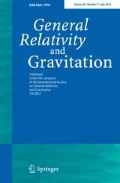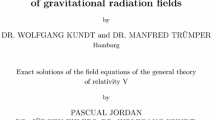Abstract
We extend Vaidya’s algorithm for the description of a central mass losing or gaining energy due to electromagnetic-type radiation (‘null dust’) to the case of arbitrary radial corpuscular radiation. We also demonstrate the remarkable possibility of purely algebraic deduction of the Vaidya solution without integrating the field equations, and interpret this possibility as an artifact of curvature coordinates. Since Vaidya’s approach by itself cannot lead to certain dependence of mass on spacetime coordinates, the search for a corresponding mass-function represents an independent issue. In this regard, as a perspective, we discuss an outlook on the problem of variable masses as a whole.
Similar content being viewed by others
References
Padmanabhan, T.: Gravitation: Foundations and Frontiers. Cambridge University Press, Cambridge (2010)
Vaidya, P.: Curr. Sci. 12, 183 (1943)
Vaidya, P.C.: Proc. Indian Acad. Sci. Sect. A 33(5), 264 (1951). https://doi.org/10.1007/BF03173260
Vaidya, P.C.: Nature 171(4345), 260 (1953). https://doi.org/10.1038/171260a0
Mychelkin, E.G., Bekov, A.A.: The Gravitational Field of the Variable Mass on the Cosmological De Sitter Background. Preprint 90-05, Astrophysical Institute of the Academy of Sciences of the Kazakh SSR, Alma-Ata (1990)
Raychaudhuri, A.K.: Zeitschrift für Physik 135(2), 225 (1953). https://doi.org/10.1007/BF01333345
Culetu, H.: (2016). http://arxiv.org/abs/1612.06009
Foster, J.C., Ray, J.R.: J. Math. Phys. 13(7), 979 (1972). https://doi.org/10.1063/1.1666097
Caban, P., Rembieliński, J., Smoliński, K.A., Walczak, Z.: Found. Phys. Lett. 19(6), 619 (2006). https://doi.org/10.1007/s10702-006-1015-4
Ehrlich, R.: Astropart. Phys. 66, 11 (2015). https://doi.org/10.1016/j.astropartphys.2014.12.011
Mychelkin, E.G., Makukov, M.A.: Int. J. Mod. Phys. D 24, 1544025 (2015). https://doi.org/10.1142/S0218271815440253
Makukov, M.A., Mychelkin, E.G., Saveliev, V.L.: Int. J. Mod. Phys. Conf. Ser. 41, 1660133 (2016). https://doi.org/10.1142/S2010194516601332
Mallett, R.L.: Phys. Rev. D 31(2), 416 (1985). https://doi.org/10.1103/PhysRevD.31.416
Kozhanov, T., Mychelkin, E.G.: Proc. Astrophys. Inst., Alma-Ata, 45, 85 (1986)
Tolman, R.C.: Relativity, Thermodynamics and Cosmology. Oxford at the Clarendon Press, London (1949)
Zhuravsky, A.: Handbook of Elliptical Functions. Academy of Science Press, Moscow (1941)
Gupta, Y.K., Gupta, S.: Gen. Relativ. Gravit. 20(12), 1293 (1988). https://doi.org/10.1007/BF00756054
Fisher, I.Z.: Zhurnal Experimental’noj i Teoreticheskoj Fiziki 18, 636 (1948)
Janis, A.I., Newman, E.T., Winicour, J.: Phys. Rev. Lett. 20(16), 878 (1968). https://doi.org/10.1103/PhysRevLett.20.878
Xanthopoulos, B.C., Zannias, T.: Phys. Rev. D 40(8), 2564 (1989). https://doi.org/10.1103/PhysRevD.40.2564
Makukov, M., Mychelkin, E.: Found. Phys. (2020). https://doi.org/10.1007/s10701-020-00384-y
Dymnikova, I.: (2000). arXiv:gr-qc/0010016
Kerr, R.P.: Phys. Rev. Lett. 11(5), 237 (1963). https://doi.org/10.1103/PhysRevLett.11.237
Newman, E.T., Janis, A.I.: J. Math. Phys. 6(6), 915 (1965). https://doi.org/10.1063/1.1704350
Choptuik, M.W.: Phys. Rev. Lett. 70(1), 9 (1993). https://doi.org/10.1103/PhysRevLett.70.9
Shaikh, A.A., Kundu, H., Sen, J.: Indian J. Math. 61, 41 (2019)
Makukov, M.A., Mychelkin, E.G.: Phys. Rev. D 98(6), 064050 (2018). https://doi.org/10.1103/PhysRevD.98.064050
Geroch, R., Traschen, J.: Phys. Rev. D 36(4), 1017 (1987). https://doi.org/10.1103/PhysRevD.36.1017
Acknowledgements
The work is partially supported within the Grant No. AP08052312 of the Ministry of Education and Science of the Republic of Kazakhstan.
Author information
Authors and Affiliations
Corresponding author
Additional information
Publisher's Note
Springer Nature remains neutral with regard to jurisdictional claims in published maps and institutional affiliations.
Rights and permissions
About this article
Cite this article
Mychelkin, E.G., Makukov, M.A. Coordinate effect: Vaidya solutions without integrating the field equations. Gen Relativ Gravit 52, 113 (2020). https://doi.org/10.1007/s10714-020-02767-y
Received:
Accepted:
Published:
DOI: https://doi.org/10.1007/s10714-020-02767-y



